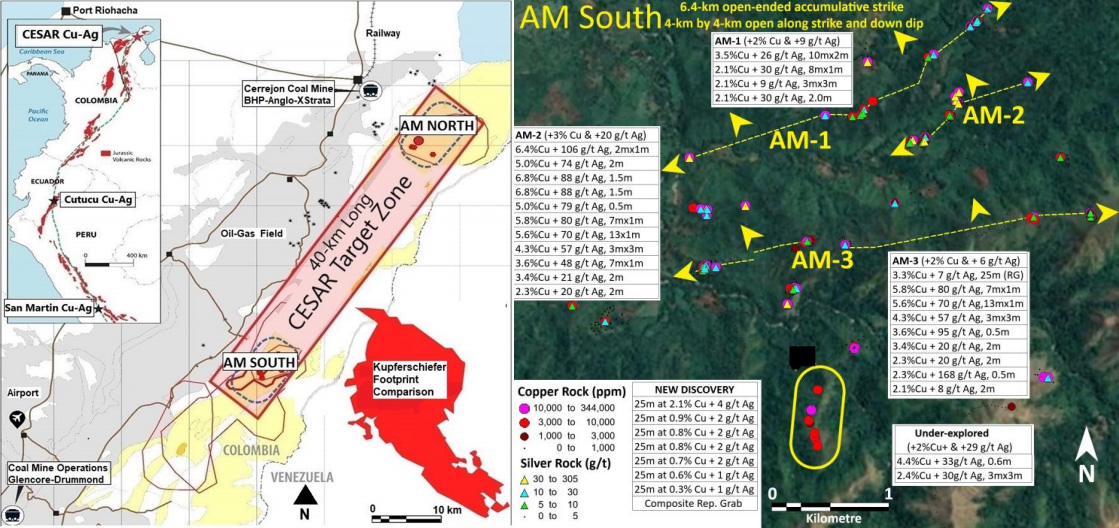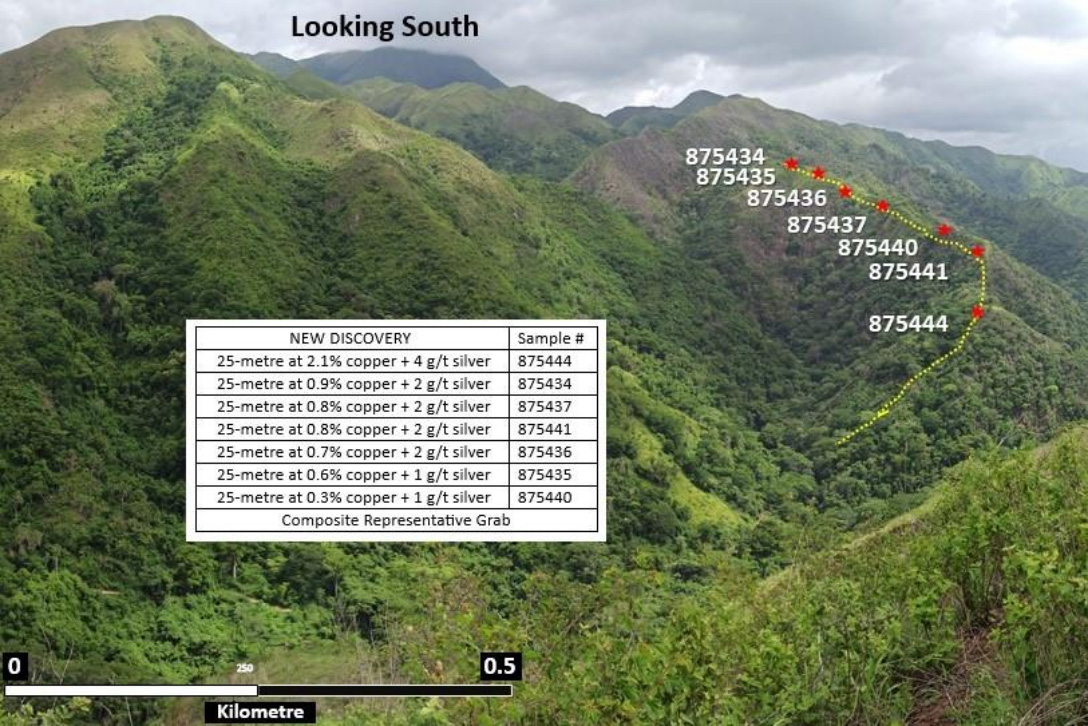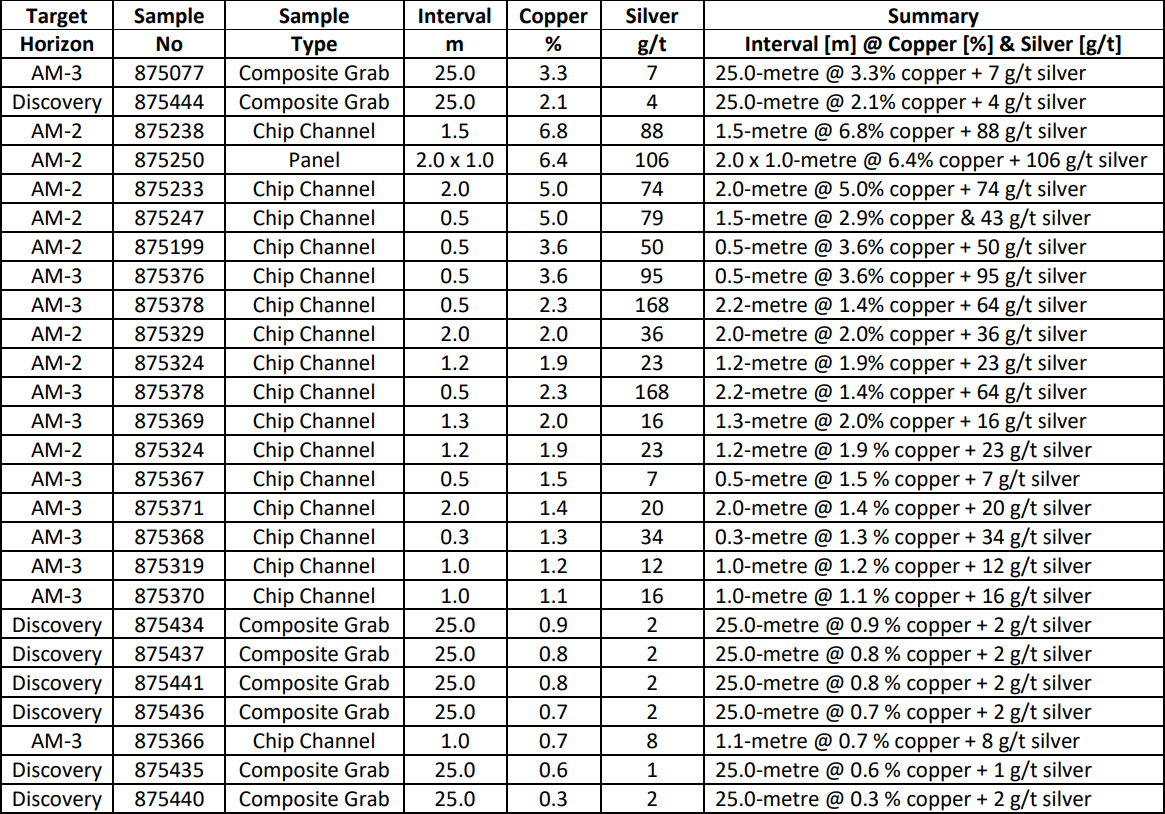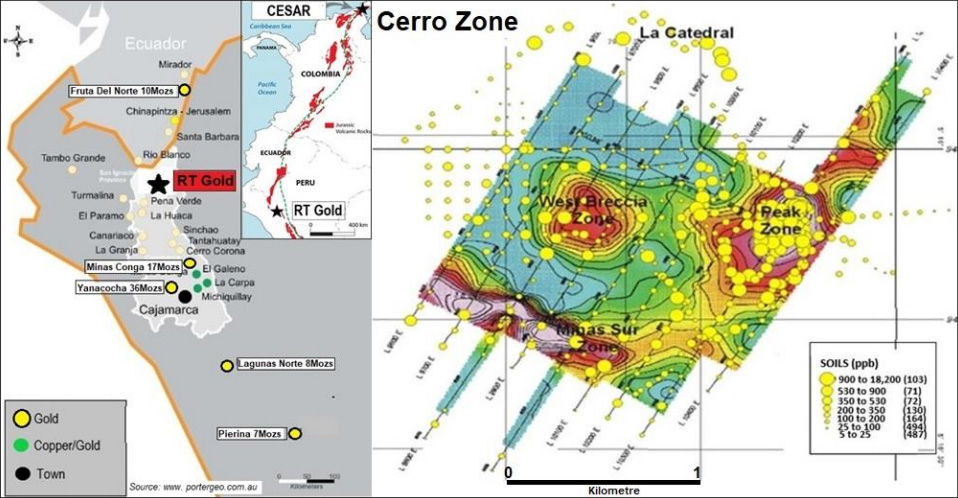Max Resource Reports Assays of 3.3% Copper Over 25-Metres and Another New Discovery at AM South, CESAR Project, NE Colombia
Vancouver B.C., October 7, 2020 – MAX RESOURCE CORP. (“Max” or the “Company”) (TSX.V: MXR; OTC: MXROF; Frankfurt: M1D2) is pleased to report new high-grade assay results along with the discovery of a new 400-metre mineralization, extending the AM South stratabound copper-silver horizon to over 6.4-kilometre of cumulative strike, at the Company’s wholly-owned CESAR copper-silver project, located 420-kilometres north of Bogota, northeast Colombia (refer to Figure 1).
Highlight AM South rock sample results include (refer to Table 1):
- 3.3% copper + 7 g/t silver over 25.0-metre interval (AM-3 composite representative grab);
- 2.1% copper + 7 g/t silver over 25.0-metre interval (New Discovery composite representative grab);
- 6.4% copper + 106 g/t silver over 2.0-metre by 1.0-metre (composite panel);
- 5.0% copper + 74 g/t silver over 2.0-metre (chip channel);
- 6.8% copper + 88 g/t silver over 1.5-metre (chip channel);
- 2.9% copper + 43 g/t silver over 1.5-metre (chip channel).
Max cautions investors that composite representative rock grab sampling can be selective.
AM-3 Stratabound Horizon: The high-grade representative grab sample located on AM-3 is open-ended over a 25-metre interval with values of 3.3% copper and 7 g/t silver and will be resampled as a series of continuous chip channels. The AM-3 stratabound horizon now extends for over 2.9-kilometres and remains open along strike and down dip.
New Discovery at AM South: Located approximately 1.0-kilometre south of AM-3, consists of 7 first pass composite representative grab sample locations over 400-metres of mineralization; all 7 were over 25-metre intervals with assays ranging from 0.3% to 2.1% copper. The New Discovery remains open, and will be resampled as a series of continuous chip channels, mapped and mineralization will be followed along its strike (refer to Figure 2).
Expansion at AM South: The stratabound copper-silver zone now covers an area of over 4-kilometres by 4- kilometres and remains opens laterally. The accumulative strike of AM-1, AM-2, AM-3 and the New Discovery is now over 6.4-kilometres and remains open along the strike and down dip (refer to Figure 1).
The AM South copper-silver mineralization is interpreted to be stratabound, hosted in fine-grained clastic sediments: sandstone and siltstone. The most common copper minerals visible on surface are copper oxides (malachite and azurite) and appear to be replaced by chalcocite at shallow depths. The general strike of the AM South copper-silver mineralization lies sub horizontal about 245 degrees with shallow dip to the NW. CESAR’s AM North zone is located 40-kilometres NNE of AM South along the same mineralized trend.
The Company believes the stratabound copper-silver mineralization at CESAR is analogous to the Kupferschiefer deposits. The Kupferschiefer mines are Europe’s largest copper source, with production in 2018 of 30MT grading 1.49% copper and 48.6 g/t silver from a mineralized zone of 0.5 to 5.5-metre thickness. The Kupferschiefer deposits, yielded 40 million ounces silver in 2019, almost twice the production of the world’s second largest silver mine (World Silver Survey 2020). Max cautions investors that the presence of stratabound copper-silver mineralization at Kupferschiefer is not necessarily indicative of similar mineralization at CESAR.
“The on-going discoveries and ever expanding widespread +1% copper plus silver mineralization over significant widths and over many square kilometres at CESAR continues to justify the potential for the CESAR basin becoming a significant copper silver region,” said Max CEO, Brett Matich.
“Our geological team’s diligence in the field continues to build and confirm the Kupferschiefer-style geological model for CESAR, as we expand the CESAR mineralization working towards our goal of the Kupferschiefer copper silver footprint,” he continued.

Figure 1. AM South: AM-1, AM-2, AM-3 and New Discovery cover over 4-km by 4-km open laterally.
As a result of the New Discovery at AM South, the copper silver mineralization now extends an additional 1.0- kilometre further south from the main structures AM-1, AM-2 and AM-3. Additional sampling and mapping are required to properly assess the significance and possible expansion of the New Discovery.

Figure 2. AM South Significant 400-metre New Discovery

Table 1. AM South: Significant rock sample assay results and sampled intervals.
Quality Assurance
All samples were shipped to the ALS Lab sample preparation facility in Medellin, Colombia. Sample pulps are sent to Vancouver, Canada for analysis. All samples are analyzed using ALS procedure ME-MS41, a four-acid digestion with ICP finish. Over limit copper and silver are determined by ALS procedure OG-62, a four-acid digestion with an AAS finish. ALS Labs is independent from Max. Max is not aware of any other factors that could materially affect the accuracy or reliability of the data referred to herein.
CESAR Copper-Silver Project - Colombia
The wholly-owned CESAR project in north east Colombia lies along a 120-kilometre sediment-hosted copper-silver belt, that resembles the Kupferschiefer in Poland. The CESAR region enjoys major infrastructure. Mining operations include Cerrejon, the largest coal mine in Latin America, jointly owned by global miners BHP Billiton, XStrata and Anglo American (Figure 1).
Important highlights and exploration activity on multiple fronts:
- AM North consists of a broad 11-kilometre continuous zone of stratabound copper-silver mineralization and is open along strike and down dip. The zone also contains a high-grade area with varying intervals grading 4.0 to 34.4% copper + 28 to 305 g/t silver (July 29, 2020). Two bulk samples extracted from each end of the 1.8-km discovery horizon, returned 9.4% copper + 79 g/t silver and 3.5 % copper + 29 g/t silver (May 21, 2020);
- The AM South zone occurs 40-km SSW of the AM North zone, within the same Kupferschiefer style mineralized trend. The AM South zone extends over an area of 4-kilometres by 4-kilometres, and remains opens laterally. The cumulative strike length of the open-ended AM South horizons exceeds 6.4-kilometres, returning highlight values of 6.8% copper and 168 g/t silver from 0.1 to 25-metre intervals, suggesting these horizons could be of significant size (October 7, 2020);
- Fathom Geophysics are currently interpreting geophysical and seismic data. The study was funded by the Company and one of the world's leading copper producers;
- Geochemical and metallurgical research programs by the University of Science and Technology (“AGH”) of Krakow, Poland are ongoing. AGH will bring their extensive knowledge of KGHM’s world renowned Kupferschiefer sediment-hosted copper-silver deposits in Poland to the CESAR project;
- Ongoing structural analysis of the CESAR target zone is being conducted by Ingeniería Geológica Universidad Nacional de Colombia (“IGUN”) in Medellín, with the assistance of the Max field team;
- Max has entered into three non-exclusive confidentially agreements regarding the CESAR project: the first with one of the world’s leading copper producers, a second with a global mining company and a third with a mid-tier copper explorer;
- Planned logging and XRF of oil/gas drill hole core/chips for the presence of copper;
- Continue to expand the landholdings along the 200-kilometre-long CESAR copper silver belt;
- Our in-country field team are focused on expanding and confirming the continuity of widespread +1% copper silver mineralization over multi-metre widths and spread over many square kilometres.
RT Gold Property – Peru
The RT Gold property consists of two contiguous mineral concessions covering 1,983 hectare and sits along the Condor mountain chain of northern Peru, within the Cajamarca Metallogenic belt, 760-km NW of Lima in the District of Tabaconas. Max has rights to acquire 100%; the option requires yearly payments of US$300,000 over four years and exercise of the option requires an additional US $3,000,00 payment on or before the fifth anniversary. The Vendors will retain 2.5% NSR.

Source: NI43:101 Geological Report Rio Tabaconas Gold Project for Golden Alliance Resources Corp. by George Sivertz, October 3, 2011
This geological belt extends from central Peru into southern Ecuador, and hosts a number of world class gold deposits, including Fruta Del Norte (10Moz), Minas Conga (17Moz), Yanacocha (36Moz), Lagunas (8Mozs) and Pierina (7Mozs). Presence of mineralization at Yanacocha, Minas Conga, Fruta Del Norte, Lagunas, Pierina is not necessarily indicative of similar mineralization at RT Gold. Source: www.portergeo.com.au
Two distinct mineralized systems occur within the RT Gold property: the Cerro Zone, a bulk tonnage gold-bearing porphyry, and 3-km to the NW, the Tablon Zone, a gold-bearing massive sulfide zone. The last field exploration was conducted a decade ago.
Cerro Zone
The Cerro Zone hosts several known mineralized zones (Peak, West, Breccia and Cathedral) with anomalous concentrations of gold in rock and soils:
- Structures assaying 0.1 to 62.9 g/t gold, hosted in mineralized wall rock returning gold values of 0.5 to 1.0 g/t gold;
- Soil geochemistry of the Cerro Zone has outlined a 2.0-km by 1.5-km gold anomaly, open in all directions grading from 0.1 to 4.0 g/t gold;
- Soil geochemistry is coincident with IP chargeability;
- The Cerro Zone has never been drill tested.
Tablon Zone
The Tablon Zone is located 3-km NW from Cerro and hosts numerous gold-bearing massive to semi-massive sulphide bodies over a 150-metre by 450-metre area, within a larger 1.0-km by 1.5-km area of anomalous gold soil and rock geochemistry. A total of 33 holes were diamond drilled in 2001 at Tablon with highlight intersections of:
- RT-03 returned 50.0 g/t gold over 0.7m from 62.2m;
- RT-06 returned 3.1 g/t gold over 21.4m from 9.1m;
- RT-11 returned 5.3 g/t gold over 17.1m from 12.0m;
- RT-13 returned 8.8 g/t gold over 25.4m from 13.4m;
- RT-21 returned 5.1 g/t gold over 19.5m from 1.5m;
- RT-22 returned 4.9 g/t gold over 14.1m from 40.1m;
- RT-25 returned 13.0 g/t gold over 36.1m from 33.0m;
- RT-26 returned 7.0 g/t gold over 6.0m from 0.0m;
- RT-29 returned 18.0 g/t gold over 16.4m from 34.9m, includes 118.1 g/t gold over 2.2m from 42.0m.
Intervals are core lengths not true widths, which are unknown at this time. Source: NI43:101 Geological Report Rio Tabaconas Gold Project for Golden Alliance Resources Corp. by George Sivertz, October 3, 2011.
The Max technical team is currently reviewing and digitizing proprietary data for subsequent interpretation for target generation. A program of field verification by Max’s in-country team: mapping, surveying and sampling is scheduled to follow. Concurrent with the verification program, the Company will be initiating drill permitting.
About Max Resource Corp.
With its successful exploration and management team, Max Resource Corp. is advancing its stratabound Kupferschiefer type CESAR copper-silver project in Colombia and its newly acquired RT Gold project in Peru. Both have potential for the discovery of large-scale mineral deposits attractive to major partners.
Tim Henneberry, P Geo (British Columbia), a member of the Max Resource Advisory Board, is the Qualified Person who has reviewed and approved the technical content of this news release on behalf of the Company.
For more information visit: https://www.maxresource.com/
For additional information contact:
Max Resource Corp.
Tim McNulty
E: info@maxresource.com
T: (604) 290-8100
Neither TSX Venture Exchange nor its Regulation Services Provider (as that term is defined in the policies of the TSX Venture Exchange) accepts responsibility for the adequacy or accuracy of this release
Except for statements of historic fact, this news release contains certain "forward-looking information" within the meaning of applicable securities law. Forward-looking information is frequently characterized by words such as "plan", "expect", "project", "intend", "believe", "anticipate", "estimate" and other similar words, or statements that certain events or conditions "may" or "will" occur. Forward-looking statements are based on the opinions and estimates at the date the statements are made and are subject to a variety of risks and uncertainties and other factors that could cause actual events or results to differ materially from those anticipated in the forward-looking statements including, but not limited to delays or uncertainties with regulatory approvals, including that of the TSXV. There are uncertainties inherent in forward-looking information, including factors beyond the Company’s control. There are no assurances that the commercialization plans for Max Resources Corp. described in this news release will come into effect on the terms or time frame described herein. The Company undertakes no obligation to update forward-looking information if circumstances or management's estimates or opinions should change except as required by law. The reader is cautioned not to place undue reliance on forward-looking statements. Additional information identifying risks and uncertainties that could affect financial results is contained in the Company’s filings with Canadian securities regulators, which filings are available at www.sedar.com
Back to Past News